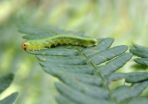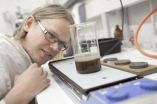(Press-News.org) In order to find out about its migrations, various research centres in South Africa, Sweden, Canada, Chile, Australia, Spain, Argentina and Switzerland have conducted research detailing its routes and expansion periods. A significant new fact has emerged and it is that the wasps returning to Europe from Chile and South Africa have undergone a genetic micro-evolution which makes them more resistant to their natural European enemy, a nematode that sterilises them.
The Sirex noctilio wasp is regarded as a secondary pest in Europe because in this geographical area there is a natural enemy preventing its spread on a large scale. It is a nematode that gets into the wasp's genital organs and sterilizes it. However, the wasp is a pest of great importance in the zones it has migrated to like Australia, South America and South Africa, where it does not have to contend with this natural enemy.
In the countries where it has been accidentally introduced, the insect can even kill a tree, because when the females lay their eggs inside the trunk, they also release a fungus and a toxic mucoid substance which kills off the specimen. As an example of its devastating effect, one can cite that in Australia it succeeded in killing 40% of the pine trees after it was introduced halfway through the last century.
The researchers want to make it quite clear that in Europe one must remain vigilant in the management of the Sirex noctilio. In the genetic analyses carried out, it has been discovered that samples originating in Chile and South Africa and which have been detected in Switzerland have undergone a genetic micro-evolution. This genetic modification makes them more resistant to the nematode that can render them sterile; so their capacity to reproduce and spread increases considerably. The specimens displaying this microevolution have an unknown genetic origin, even though specialists believe that they may have originated in Asia or North Africa.
Migratory routes and times
By combining molecular studies, experts have managed to establish the migratory routes of this species. According to their conclusions, the first presence of the wasp outside its native habitat was recorded in New Zealand in 1900, and the next one was recorded in Australia in 1961. Its advance continued from Europe and Oceania towards South America, where it settled in Uruguay in 1980, Argentina in 1985, and Chile in 2001. From the Southern Cone and Oceania, the wasp reached South Africa in 1994. The next migration took place from Europe and South America towards the United States and Canada where it settled in 2004 and 2005, respectively.
To conduct this research, the researchers have genetically studied 500 specimens of the Sirex noctilio. The specimens captured on the Iberian Peninsula were analysed by the Basque Institute for Agricultural Research and Development, Neiker-Tecnalia.
###The research was led by E. Boissim, member of the Forestry and Agricultural Biotechnology Institute of the University of Pretoria (South Africa), and has had the participation of the following people: M. J. Wingfield, B. Slippers and B. Hurley, of the University of Pretoria (South Africa); R. Vasaitis and J . Stenlid, of the Swedish University of Agricultural Sciences; C. Davis and P. De Groots, of the Canadian Forest Service, Ontario (Canada); R. Ahumada, of Bioforest S. A., Concepción (Chile); A. Carnegie, of the Forest Science Centre, Beecroft (Australia); A. Goldarazena, of the Basque Institute for Agricultural Research and Development Neiker-Tecnalia, Vitoria-Gasteiz (Basque Country, Spain); P. Klasmer, of the Insect Ecology Laboratory, Bariloche (Argentina); and B. Wermelinger, of the Swiss Federal Institute for Forest, Snow and Landscape Research WSL, Birmensdorf (Switzerland).
Researchers detail the migrations of the wood wasp Sirex noctilio
2012-11-21
ELSE PRESS RELEASES FROM THIS DATE:
VTT: Indicators and methods of sustainable development 1-sided
2012-11-21
"Methods are required that take the social and environmental impacts of business operations better into account, both within the company and among its network of partners and stakeholders," says Uusitalo. "If a change cannot be effected, the current unsustainable way of life will continue, and we might also miss some opportunities for creating new business. Market share is at stake here."
According to Uusitalo, other companies and customers demand that companies take a wider view of sustainable development.
"Legislation will also inevitably lead development in this ...
Herbivore defense in ferns
2012-11-21
This press release is available in German.
They dominated the earth for 200 million years and numerous different species can still be found all over the world: mosses, horsetails and ferns. Researchers from the Max Planck Institute for Chemical Ecology in Jena, Germany, have now found out that bracken ferns (Pteridium aquilinum) do not release any volatiles when they are attacked − unlike many of the now dominant and evolutionary younger flowering plants. Such an emission of volatile compounds may attract the pest insects' enemies, such as ichneumon wasps or ...
Researchers identify a simple way to precipitate phosphorus from the wastewater of a pulp mill
2012-11-21
Researchers at Aalto University have developed a simple method for reducing the amount of phosphorus in the wastewater of a pulp mill. The method is called simultaneous precipitation using iron sulphate. A separate treatment stage is not required, as the precipitation takes place simultaneously with the actual biological wastewater treatment.
Iron sulphate is added to the wastewater prior to the biological wastewater treatment process, and the phosphorus dissolved into the water is precipitated with the biomass at the treatment plant. Finally, the phosphorus is removed ...
'Trust' provides answer to handaxe enigma
2012-11-21
Trust rather than lust is at the heart of the attention to detail and finely made form of handaxes from around 1.7 million years ago, according to a University of York researcher.
Dr Penny Spikins, from the Department of Archaeology, suggests a desire to prove their trustworthiness, rather than a need to demonstrate their physical fitness as a mate, was the driving force behind the fine crafting of handaxes by Homo erectus/ergaster in the Lower Palaeolithic period.
Dr Spikins said: "We sometimes imagine that early humans were self-centred, and if emotional at all, that ...
Ocean currents play a role in predicting extent of Arctic sea ice
2012-11-21
CAMBRIDGE, MA -- Each winter, wide swaths of the Arctic Ocean freeze to form sheets of sea ice that spread over millions of square miles. This ice acts as a massive sun visor for the Earth, reflecting solar radiation and shielding the planet from excessive warming.
The Arctic ice cover reaches its peak each year in mid-March, before shrinking with warmer spring temperatures. But over the last three decades, this winter ice cap has shrunk: Its annual maximum reached record lows, according to satellite observations, in 2007 and again in 2011.
Understanding the processes ...
Daily steps add up for midlife women's health
2012-11-21
CLEVELAND, Ohio (November 21, 2012)—Moving 6,000 or more steps a day—no matter how—adds up to a healthier life for midlife women. That level of physical activity decreases the risk of diabetes and metabolic syndrome (a diabetes precursor and a risk for cardiovascular disease), showed a study published online this month in Menopause, the journal of the North American Menopause Society.
Although other studies have shown the value of structured exercise in lowering health risks such as diabetes, high blood pressure, and heart disease, this study has shown that habitual physical ...
Brainy babies – Research explores infants' skills and abilities
2012-11-21
Infants seem to develop at an astoundingly rapid pace, learning new things and acquiring new skills every day. And research suggests that the abilities that infants demonstrate early on can shape the development of skills later in life, in childhood and beyond.
Read about the latest research on infant development published in the November 2012 issue of Psychological Science, a journal of the Association for Psychological Science.
How Do You Learn to Walk? Thousands of Steps and Dozens of Falls per Day
How do babies learn to walk? In this study, psychological scientist ...
Short DNA strands in the genome may be key to understanding human cognition and diseases
2012-11-21
Short snippets of DNA found in human brain tissue provide new insight into human cognitive function and risk for developing certain neurological diseases, according to researchers from the Departments of Psychiatry and Neuroscience at Mount Sinai School of Medicine. The findings are published in the November 20th issue of PLoS Biology.
There are nearly 40 million positions in the human genome with DNA sequences that are different than those in non-human primates, making the task of learning which are important and which are inconsequential a challenge for scientists. ...
It takes two to tangle: Wistar scientists further unravel telomere biology
2012-11-21
Chromosomes - long, linear DNA molecules – are capped at their ends with special DNA structures called telomeres and an assortment of proteins, which together act as a protective sheath. Telomeres are maintained through the interactions between an enzyme, telomerase, and several accessory proteins. Researchers at The Wistar Institute have defined the structure of one of these critical proteins in yeast.
Understanding how telomeres keep chromosomes – and by extension, genomes – intact is an area of intense scientific focus in the fields of both aging and cancer. In aging, ...
Pathway identified in human lymphoma points way to new blood cancer treatments
2012-11-21
PHILADELPHIA – A pathway called the "Unfolded Protein Response," or UPR, a cell's way of responding to unfolded and misfolded proteins, helps tumor cells escape programmed cell death during the development of lymphoma.
Research, led by Lori Hart, Ph.D., research associate and Constantinos Koumenis, Ph.D., associate professor,and research division director in the Department of Radiation Oncology, both from the Perelman School of Medicine, University of Pennsylvania, and Davide Ruggero, Ph.D., associate professor, Department of Urology, University of California, San Francisco, ...


